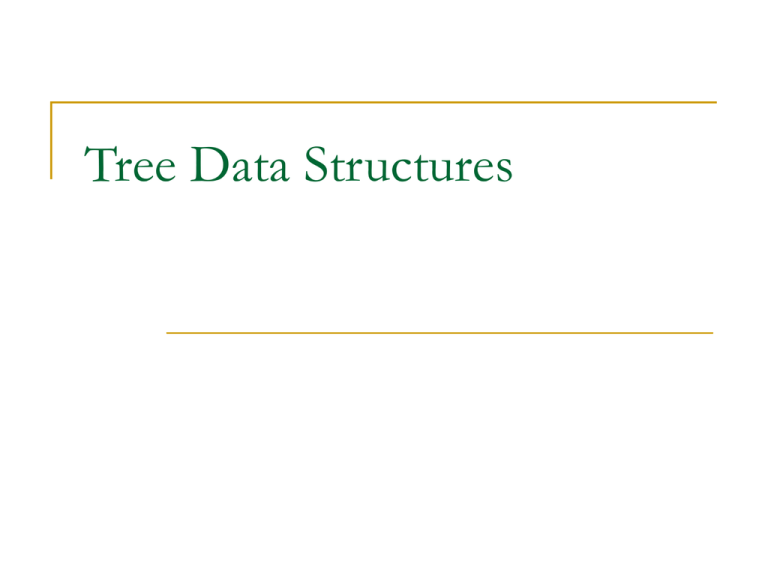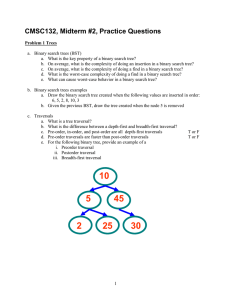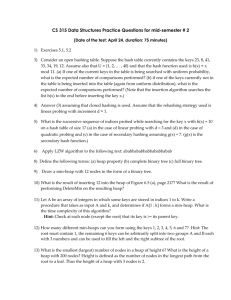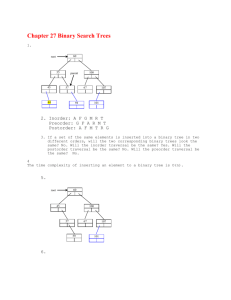Binary Trees
advertisement

Tree Data Structures
Trees Data Structures
Tree
Nodes
Each node can have 0 or more children
A node can have at most one parent
Binary tree
Tree with 0–2 children per node
Tree
Binary Tree
Trees
Terminology
Root no parent
Leaf no child
Interior non-leaf
Height distance from root to leaf
Root node
Interior nodes
Leaf nodes
Height
Binary Search Trees
Key property
Value at node
Smaller values in left subtree
Larger values in right subtree
Example
X
X>Y
X<Z
Y
Z
Binary Search Trees
Examples
5
10
2
5
10
45
30
5
45
30
2
25
45
2
10
25
30
25
Binary
search trees
Not a binary
search tree
Iterative Search of Binary Tree
Node *Find( Node *n, int key) {
while (n != NULL) {
if (n->data == key) // Found it
return n;
if (n->data > key)
// In left subtree
n = n->left;
else
// In right subtree
n = n->right;
}
return null;
}
Node * n = Find( root, 5);
Example Binary Searches
Find ( root, 2 )
root
10
5
5
10 > 2, left
30
5 > 2, left
2
45
2 = 2, found
2
25
30
45
5 > 2, left
10
25
2 = 2, found
Example Binary Searches
Find (root, 25 )
10
5
5
10 < 25, right
30
30 > 25, left
2
45
25 = 25, found
2
25
5 < 25, right
45 > 25, left
30 > 25, left
30
45
10
10 < 25, right
25 = 25, found
25
Types of Binary Trees
Degenerate – only one child
Complete (Full)– always two children
Balanced – “mostly” two children
more formal definitions exist, above are intuitive ideas
Degenerate
binary tree
Balanced
binary tree
Complete
binary tree
Binary Trees Properties
Degenerate
Height = O(n) for n
nodes
Similar to linked list
Degenerate
binary tree
Balanced
Height = O( log(n) )
for n nodes
Useful for searches
Balanced
binary tree
Binary Search Properties
Time of search
Proportional to height of tree
Balanced binary tree
O( log(n) ) time
Degenerate tree
O( n ) time
Like searching linked list / unsorted array
Binary Search Tree Construction
How to build & maintain binary trees?
Insertion
Deletion
Maintain key property (invariant)
Smaller values in left subtree
Larger values in right subtree
Binary Search Tree – Insertion
Algorithm
1.
2.
3.
4.
Perform search for value X
Search will end at node Y (if X not in tree)
If X < Y, insert new leaf X as new left subtree for
Y
If X > Y, insert new leaf X as new right subtree
for Y
Observations
O( log(n) ) operation for balanced tree
Insertions may unbalance tree
Example Insertion
Insert ( 20 )
10
5
10 < 20, right
30 > 20, left
30
25 > 20, left
2
25
20
45
Insert 20 on left
Binary Search Tree – Deletion
Algorithm
1.
2.
3.
Perform search for value X
If X is a leaf, delete X
Else // must delete internal node
a) Replace with largest value Y on left subtree
OR smallest value Z on right subtree
b) Delete replacement value (Y or Z) from subtree
Observation
O( log(n) ) operation for balanced tree
Deletions may unbalance tree
Example Deletion (Leaf)
Delete ( 25 )
10
5
10
10 < 25, right
30
5
30 > 25, left
30
25 = 25, delete
2
25
45
2
45
Example Deletion (Internal Node)
Delete ( 10 )
10
5
2
5
30
25
5
45
Replacing 10
with largest
value in left
subtree
2
5
30
25
2
45
Replacing 5
with largest
value in left
subtree
2
30
25
45
Deleting leaf
Example Deletion (Internal Node)
Delete ( 10 )
10
5
2
25
30
25
5
45
Replacing 10
with smallest
value in right
subtree
2
25
30
25
5
45
Deleting leaf
2
30
45
Resulting tree
Balanced Search Trees
Kinds of balanced binary search trees
height balanced vs. weight balanced
“Tree rotations” used to maintain balance on insert/delete
Non-binary search trees
2/3 trees
each internal node has 2 or 3 children
all leaves at same depth (height balanced)
B-trees
Generalization of 2/3 trees
Each internal node has between k/2 and k children
Each node has an array of pointers to children
Widely used in databases
Other (Non-Search) Trees
Parse trees
Convert from textual representation to tree
representation
Textual program to tree
Used extensively in compilers
Tree representation of data
E.g. HTML data can be represented as a tree
called DOM (Document Object Model) tree
XML
Like HTML, but used to represent data
Tree structured
Parse Trees
Expressions, programs, etc can be
represented by tree structures
E.g. Arithmetic Expression Tree
A-(C/5 * 2) + (D*5 % 4)
+
A
*
/
C 5
%
*
2
D 5
4
Preoder, Inorder, Postorder
In Preorder, the root
is visited before (pre)
the subtrees traversals
In Inorder, the root is
visited in-between left
and right subtree traversal
In Preorder, the root
is visited after (pre)
the subtrees traversals
Preorder Traversal:
1. Visit the root
2. Traverse left subtree
3. Traverse right subtree
Inorder Traversal:
1. Traverse left subtree
2. Visit the root
3. Traverse right subtree
Postorder Traversal:
1. Traverse left subtree
2. Traverse right subtree
3. Visit the root
Tree Traversal
+
Goal: visit every node of a tree
in-order traversal
A
*
/
C 5
void Node::inOrder () {
if (left != NULL) {
cout << “(“; left->inOrder(); cout << “)”;
}
cout << data << endl;
if (right != NULL) right->inOrder()
}Output: A – C / 5 * 2 + D * 5 % 4
To disambiguate: print brackets
%
*
2
D 5
4
Tree Traversal (contd.)
+
pre-order and post-order:
void Node::preOrder () {
cout << data << endl;
if (left != NULL) left->preOrder ();
if (right != NULL) right->preOrder ();
}
A
*
/
%
*
2
C 5
Output: + - A * / C 5 2 % * D 5 4
void Node::postOrder () {
if (left != NULL) left->preOrder ();
if (right != NULL) right->preOrder ();
cout << data << endl;
}
Output: A C 5 / 2 * - D 5 * 4 % +
D 5
4
More Illustrations for Traversals
Assume: visiting a node
is printing its label
Preorder:
1 3 5 4 6 7 8 9 10 11 12
4
Inorder:
4 5 6 3 1 8 7 9 11 10 12
Postorder:
4 6 5 3 8 11 12 10 9 7 1
1
3
7
5
8
9
10
6
11
12
More Illustrations for Traversals (Contd.)
Assume: visiting a node
15
20
8
is printing its data
Preorder: 15 8 2 6 3 7
27
11
2
11 10 12 14 20 27 22 30
6 10 12 22 30
Inorder: 2 3 6 7 8 10 11
3 7
14
12 14 15 20 22 27 30
Postorder: 3 7 6 2 10 14
12 11 8 22 30 27 20 15
Application of Traversal Sorting
a BST
Observe the output of the inorder
traversal of the BST example two slides
earlier
It is sorted
This is no coincidence
As a general rule, if you output the keys
(data) of the nodes of a BST using
inorder traversal, the data comes out
sorted in increasing order
Array Representation of Full Trees and
Almost Complete Trees
A canonically label-able tree, like full binary trees
and almost complete binary trees, can be
represented by an array A of the same length as the
number of nodes
A[k] is identified with node of label k
That is, A[k] holds the data of node k
Advantage:
no need to store left and right pointers in the nodes save
memory
Direct access to nodes: to get to node k, access A[k]
Illustration of Array Representation
15
20
8
2
13
15
1
8 20 2
2
3
4
30
11
6
18
27
12
11 30 27 13 6 10 12
5 6 7 8 9 10 11
Notice: Left child of A[5] (of data 11) is A[2*5]=A[10] (of data 18),
and its right child is A[2*5+1]=A[11] (of data 12).
Parent of A[4] is A[4/2]=A[2], and parent of A[5]=A[5/2]=A[2]
Application of Almost Complete Binary
Trees: Heaps
A heap (or min-heap to be precise) is an
almost complete binary tree where
Every node holds a data value (or key)
The key of every node is ≤ the keys of the children
Note:
A max-heap has the same definition except that the
Key of every node is >= the keys of the children
Example of a Min-heap
5
20
8
15
33
16 18
30
11
12
27
Operations on Heaps
Delete the minimum value and return it.
This operation is called deleteMin.
Insert a new data value
Applications of Heaps:
• A heap implements a priority queue, which is a queue
that orders entities not a on first-come first-serve basis,
but on a priority basis: the item of highest priority is at
the head, and the item of the lowest priority is at the tail
• Another application: sorting, which will be seen later
DeleteMin in Min-heaps
The minimum value in a min-heap is at the root!
To delete the min, you can’t just remove the data
value of the root, because every node must hold a
key
Instead, take the last node from the heap, move its
key to the root, and delete that last node
But now, the tree is no longer a heap (still almost
complete, but the root key value may no longer be ≤
the keys of its children
Illustration of First Stage of deletemin
5
15
33
15
30 27
11
20
8
20
8
16 18 12
16 18
33
30
11
12
12
15
33
16 18
12
20
8
11
30
27
20
8
27
15
33
16 18
11
30
27
Restore Heap
To bring the structure back to its
“heapness”, we restore the heap
Swap the new root key with the smaller
child.
Now the potential bug is at the one level
down. If it is not already ≤ the keys of its
children, swap it with its smaller child
Keep repeating the last step until the “bug” key
becomes ≤ its children, or the it becomes a leaf
Illustration of Restore-Heap
12
20
8
15
33
8
11
30
20
12
27
16 18
15
33
11
16 18
8
20
11
15
33
16 18
12
30
27
Now it is a correct heap
30
27
XML
Data Representation
E.g.
<dependency>
<object>sample1.o</object>
<depends>sample1.cpp</depends>
<depends>sample1.h</depends>
<rule>g++ -c sample1.cpp</rule>
</dependency>
Tree representation
dependency
object
sample1.o
depends
depends
sample1.cpp
sample1.h
rule
g++ -c …
Heaps (Ref.
www.cse.unt.edu/~rada/CSCE3110/Lectures/Heaps.ppt )
A heap is a binary tree T that stores a keyelement pairs at its internal nodes
It satisfies two properties:
• MinHeap: key(parent) key(child)
• [OR MaxHeap: key(parent) key(child)]
4
• all levels are full, except
6
the last one, which is5
left-filled
15
16
9
25
14
7
12
11
20
8
What are Heaps Useful for?
To implement priority queues
Priority queue = a queue where all elements
have a “priority” associated with them
Remove in a priority queue removes the
element with the smallest priority
insert
removeMin
Heap or Not a Heap?
Heap Properties
A heap T storing n keys has height h = log(n + 1),
which is O(log n)
4
5
6
15
16
9
25
14
7
12
11
20
8
Heap Insertion
Insert 6
Heap Insertion
Add key in next available position
Heap Insertion
Begin Unheap
Heap Insertion
Heap Insertion
Terminate unheap when
reach root
key child is greater than key parent
Heap Removal
Remove element
from priority queues?
removeMin( )
Heap Removal
Begin downheap
Heap Removal
Heap Removal
Heap Removal
Terminate downheap when
reach leaf level
key parent is greater than key child
Building a Heap
build (n + 1)/2 trivial one-element heaps
build three-element heaps on top of them
Building a Heap
downheap to preserve the order property
now form seven-element heaps
Building a Heap
Building a Heap
Heap Implementation
Using arrays
Parent = k ; Children = 2k , 2k+1
Why is it efficient?
[1]
[2] 12
[3] 7
[5]
[4] 18
[1] 6
6
19
[6]
9
[2] 9
[4]
10
[3] 7
[1] 30
[2]
31







